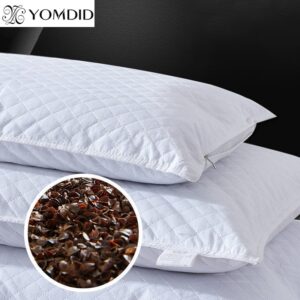Choosing the Perfect Pillow
A Guide to Choosing the Perfect Pillow for Your Sleep Style

Welcome to the ultimate guide on choosing the perfect pillow for your sleep style. We all know the importance of a good night’s sleep, and having the right pillow can make all the difference. But with so many options available, how do you know which one is right for you?
In this article, we will walk you through the different types of pillows available, from memory foam to down alternative, and help you determine which one will provide the perfect balance of support and comfort for a restful night’s sleep. We will delve into the specific needs of back, side, and stomach sleepers, and offer tips on how to find the right pillow height and firmness for your individual preferences.
Our expert advice will debunk common pillow myths and provide you with practical information to help you make an informed decision. Whether you suffer from neck pain, snore, or simply want to elevate your sleep experience, this guide has got you covered. Get ready to sleep soundly and wake up feeling refreshed and rejuvenated.
Why Choosing the Right Pillow is Important for a Good Night’s Sleep?
Sleep is essential for our health and well-being, but many people struggle to get enough quality sleep every night. One of the factors that can affect your sleep quality is the pillow you use. The right pillow can support your head, neck and spine, and help you maintain a comfortable and natural posture throughout the night. The wrong pillow, on the other hand, can cause neck pain, headaches, snoring, allergies and other problems that can disrupt your sleep and affect your daytime performance.
There are many types of pillows available on the market, such as feather, down, memory foam, latex, buckwheat and more. Each type has its own advantages and disadvantages, depending on your personal preferences, sleeping position and health conditions. For example, feather and down pillows are soft and fluffy, but they can also trigger allergies and lose their shape over time. Memory foam pillows are supportive and conform to your head and neck shape, but they can also retain heat and emit unpleasant odours. Latex pillows are durable and hypoallergenic, but they can also be heavy and expensive.
To choose the right pillow for yourself, you need to consider several factors, such as:
- Your sleeping position: Whether you sleep on your back, side or stomach, you need a pillow that can align your head, neck and spine in a neutral position. Back sleepers may need a medium-firm pillow that can support the natural curve of the neck. Side sleepers may need a firmer pillow that can fill the gap between the shoulder and the ear. Stomach sleepers may need a soft or flat pillow that can prevent the head from tilting too far back or forward.
- Your body size: The size of your pillow should match the size of your bed and your body. A pillow that is too small or too large can cause discomfort and affect your posture. You may also need to adjust the height of your pillow by adding or removing fillings or using extra pillows to achieve optimal support.
- Your comfort level: The feel of your pillow should suit your personal preference and comfort level. Some people like a soft and fluffy pillow that they can hug or mould to their liking. Others like a firm and supportive pillow that can keep its shape and provide consistent pressure relief. You may also have a preference for the material, texture, temperature and odour of your pillow.
- Your health conditions: If you have any health issues that affect your sleep quality, such as allergies, asthma, snoring, sleep apnea, insomnia or chronic pain, you may need a special type of pillow that can address your specific needs. For example, if you have allergies or asthma, you may need a hypoallergenic pillow that can resist dust mites, mould and bacteria. If you snore or have sleep apnea, you may need a cervical or contour pillow that can elevate your head and open your airways. If you have insomnia or chronic pain, you may need a weighted or aromatherapy pillow that can promote relaxation and reduce stress.
Choosing the right pillow is important for a good night’s sleep, but it is not the only factor. You also need to take care of other aspects of your sleep hygiene, such as keeping a regular sleep schedule, avoiding caffeine and alcohol before bed, creating a dark and quiet environment in your bedroom, and following a relaxing bedtime routine. By doing so, you can improve your sleep quality and enjoy the benefits of a restful and refreshing sleep.
Different Sleep Positions and their Impact on Pillow Selection

Sleeping is an essential part of our daily lives, but not everyone sleeps the same way. Some people prefer to sleep on their back, some on their side, and some on their stomach. Each sleep position has its own advantages and disadvantages, and also affects the type of pillow that is best suited for optimal comfort and support.
Back sleepers tend to need a medium-firm pillow that can support their head, neck, and spine in a neutral alignment. A pillow that is too soft or too high can cause the head to tilt back or forward, leading to neck pain and snoring. A pillow that is too hard or too low can create pressure points and reduce blood circulation. Back sleepers may benefit from a memory foam, latex, or hybrid pillow that can conform to their head shape and adjust to their movements.
Side sleepers usually need a firmer and higher pillow that can fill the gap between their ear and shoulder. A pillow that is too soft or too low can cause the head to sag and strain the neck and shoulder muscles. A pillow that is too hard or too high can push the head up and misalign the spine. Side sleepers may benefit from a down, feather, or buckwheat pillow that can provide softness and loft.
Stomach sleepers generally need a softer and lower pillow that can prevent their head from being lifted too high and twisting their neck. A pillow that is too firm or too high can cause the head to tilt up and compress the airways, leading to breathing difficulties and snoring. A pillow that is too soft or too low can also cause the head to sink and restrict the oxygen intake. Stomach sleepers may benefit from a down alternative, cotton, or silk pillow that can offer breathability and moldability.
Types of Pillows – Memory Foam, Down, Feather, and more
Pillows are essential for a good night’s sleep, but not all pillows are created equal. There are many types of pillows available on the market, each with its own advantages and disadvantages. Here are some of the most common types of pillows and what they can offer you.
- Memory Foam Pillows: These pillows are made of a material that conforms to your head and neck shape, providing optimal support and comfort. Memory foam pillows can help reduce pressure points, align your spine, and prevent snoring. However, they can also be expensive, heavy, and retain heat.
- Down Pillows: These pillows are filled with the soft and fluffy feathers from the undercoat of ducks or geese. Down pillows are very light, soft, and cosy, making them ideal for cuddling and cold weather. However, they can also be allergenic, expensive, and lose their shape over time.
- Feather Pillows: These pillows are similar to down pillows, but they contain the outer feathers of ducks or geese as well as the undercoat. Feather pillows are firmer and more supportive than down pillows, but they can also be noisy, prickly, and flatten easily.
- Synthetic Pillows: These pillows are made of polyester or other synthetic fibres that mimic the feel of natural materials. Synthetic pillows are usually cheaper, hypoallergenic, and easy to wash. However, they can also be less breathable, less durable, and more prone to clumping.
- Latex Pillows: These pillows are made of natural or synthetic rubber that has a springy and resilient feel. Latex pillows can offer good support, contouring, and pressure relief for your head and neck. However, they can also be expensive, heavy, and have a strong odour.
- Buckwheat Pillows: These pillows are filled with the hulls of buckwheat seeds that create a firm and adjustable surface. Buckwheat pillows can conform to your shape, provide good air circulation, and last for a long time. However, they can also be noisy, hard, and attract bugs.
Assessing Pillow Firmness and Loft for your Sleep Style
Pillow firmness and loft are two important factors that affect the quality of your sleep. Pillow firmness refers to how soft or hard the pillow feels, while pillow loft refers to how high or low the pillow is. The ideal pillow firmness and loft depend on your sleep style, which is the position you usually sleep in. Here are some general guidelines to help you choose the right pillow for your sleep style.
- If you are a back sleeper, you need a medium-firm pillow with a medium loft. This will support your head and neck without pushing them too far forward or backward. A medium-firm pillow will also prevent your head from sinking too deep into the pillow, which can cause snoring or breathing problems.
- If you are a side sleeper, you need a firm pillow with a high loft. This will fill the gap between your shoulder and your ear, keeping your spine aligned and your neck comfortable. A firm pillow will also prevent your head from tilting too much to one side, which can cause neck pain or stiffness.
- If you are a stomach sleeper, you need a soft pillow with a low loft. This will allow your head to rest at a natural angle, without straining your neck or back. A soft pillow will also reduce the pressure on your face, which can cause wrinkles or acne.
- If you are a combination sleeper, meaning you change positions throughout the night, you need a versatile pillow that can adapt to your movements. You can look for an adjustable pillow that lets you change the firmness and loft by adding or removing fillings, or a contour pillow that has different shapes and heights on each side.
Factors to Consider when Choosing a Pillow – Hypoallergenic, Temperature Regulation, and more
A good pillow can make a big difference in the quality of your sleep and your overall health. But how do you choose the right one for you? There are many factors to consider, such as your sleeping position, your personal preferences, and your budget. Here are some of the most important ones:
- Hypoallergenic: If you suffer from allergies or asthma, you may want to opt for a pillow that is hypoallergenic, meaning it does not contain any materials that can trigger an allergic reaction. Some common allergens are dust mites, mould, and feathers. Hypoallergenic pillows are usually made of synthetic fibres, such as polyester or memory foam, that are resistant to these allergens. They may also have a protective cover that can be washed regularly to keep them clean and fresh.
- Temperature regulation: Another factor to consider is how well the pillow regulates your body temperature during the night. Some people tend to sleep hot, while others feel cold easily. A pillow that is too warm or too cold can disrupt your sleep and make you uncomfortable. To avoid this, look for a pillow that has a breathable fabric and a filling that adapts to your body heat. For example, wool and cotton are natural materials that can keep you cool in the summer and warm in the winter. Memory foam and latex are synthetic materials that can conform to your head and neck shape and provide good support, but they may also retain heat and make you sweat.
- Firmness: The firmness of the pillow is another important factor that depends on your sleeping position and your comfort level. Generally speaking, side sleepers need a firmer pillow to support their head and neck alignment, while back sleepers need a medium-firm pillow to maintain their natural spine curvature. Stomach sleepers need a soft pillow to avoid straining their neck and lower back. However, this is not a hard-and-fast rule, as some people may prefer a different level of firmness depending on their personal preference and health conditions.
- Size and shape: The size and shape of the pillow also matter when it comes to choosing the right one for you. The size of the pillow should match the size of your bed and your head. A pillow that is too small or too large may not provide adequate support or comfort. The shape of the pillow should also suit your sleeping position and your needs. There are many different shapes available, such as standard, contour, wedge, bolster, body, and cervical pillows. Each one has its own advantages and disadvantages depending on how you use it.
- Other features: Finally, there are some other features that you may want to look for when buying a new pillow, such as durability, warranty, ease of care, odour resistance, and eco-friendliness. A good pillow should last for several years without losing its shape or quality. It should also come with a warranty that covers any defects or damages that may occur during normal use. A good pillow should also be easy to care for, meaning it can be washed or cleaned regularly without losing its properties or causing any harm to the environment. A good pillow should also be odour-resistant, meaning it does not emit any unpleasant smells or attract any pests. A good pillow should also be eco-friendly, meaning it is made of natural or organic materials that do not harm the environment or your health.
The Role of Pillow Size and Shape in Sleep Comfort

Sleep comfort is an important factor for the quality of life and health of individuals. One of the factors that can affect sleep comfort is the pillow size and shape. The pillow size and shape can influence the alignment of the head, neck and spine, as well as the pressure distribution, temperature regulation and airflow around the face and head. The optimal pillow size and shape may vary depending on the individual’s preferences, sleeping posture, body dimensions, mattress characteristics and environmental conditions. Therefore, it is essential to choose a pillow that suits one’s needs and preferences, and to adjust it accordingly during the night. This article reviews the current literature on the role of pillow size and shape in sleep comfort, and provides some practical recommendations for selecting and using pillows.
Pillow Care and Maintenance Tips for Longevity and Hygiene
Pillows are essential for a good night’s sleep, but they can also harbor dust, dirt, allergens, and bacteria. To keep your pillows fresh and healthy, you need to take proper care of them and follow some simple maintenance tips. Here are some ways to extend the lifespan and hygiene of your pillows:
- Wash your pillows regularly. Depending on the type of pillow you have, you can either machine wash or hand wash them. Check the care label for instructions and use mild detergent and warm water. Avoid using bleach or fabric softener, as they can damage the pillow’s material and reduce its fluffiness.
- Dry your pillows thoroughly. After washing, make sure your pillows are completely dry before putting them back on your bed. You can either air dry them or use a dryer on low heat. Fluff your pillows occasionally to prevent clumping and restore their shape.
- Use pillow protectors. Pillow protectors are covers that go over your pillows and under your pillowcases. They help prevent stains, spills, dust mites, and other contaminants from reaching your pillows. You can find pillow protectors made of cotton, polyester, or waterproof materials. Wash them every few weeks along with your pillowcases.
- Replace your pillows when needed. Even with proper care, pillows will eventually lose their support and comfort. A general rule of thumb is to replace your pillows every one to two years, depending on how often you use them and how well you maintain them. You can test if your pillow needs replacing by folding it in half and seeing if it springs back. If it stays folded or feels lumpy, it’s time for a new pillow.
Conclusion – Finding your Perfect Pillow for a Restful Sleep

A good night’s sleep is essential for your health and well-being. However, many people struggle to find the perfect pillow that suits their sleeping style, preferences and needs. In this article, we have discussed some of the factors that you should consider when choosing a pillow, such as the size, shape, material, firmness and loft. We have also reviewed some of the best pillows available on the market, based on customer feedback, expert opinions and quality standards. We hope that this guide has helped you narrow down your options and find your perfect pillow for a restful sleep. Remember, there is no one-size-fits-all solution when it comes to pillows, so you may need to experiment with different types and brands until you find the one that works for you. Happy sleeping!
